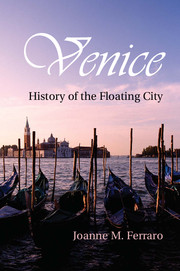Book contents
- Frontmatter
- Contents
- Plates
- Illustrations
- Maps
- Acknowledgments
- Preface
- Chronology of Historical Events
- 1 Reconstructing the Floating City
- 2 The Riches of Asia, Europe, and North Africa
- 3 A Pride of Lions
- 4 Identities and Modes of Socialization
- 5 Material Life
- 6 City of Myth
- 7 The Serenissima’s Wayward Subjects
- 8 The Baroque Stage
- 9 Epilogue
- Appendix I Approximate Population of Venice during the Republic
- Appendix II Population of the Historic Center of Venice, 1871–2010
- Glossary
- Notes
- Bibliography
- Index
- Plate Section
- References
1 - Reconstructing the Floating City
Published online by Cambridge University Press: 05 August 2012
- Frontmatter
- Contents
- Plates
- Illustrations
- Maps
- Acknowledgments
- Preface
- Chronology of Historical Events
- 1 Reconstructing the Floating City
- 2 The Riches of Asia, Europe, and North Africa
- 3 A Pride of Lions
- 4 Identities and Modes of Socialization
- 5 Material Life
- 6 City of Myth
- 7 The Serenissima’s Wayward Subjects
- 8 The Baroque Stage
- 9 Epilogue
- Appendix I Approximate Population of Venice during the Republic
- Appendix II Population of the Historic Center of Venice, 1871–2010
- Glossary
- Notes
- Bibliography
- Index
- Plate Section
- References
Summary
The most august city of Venice is today the one home of liberty, peace, and justice, the one refuge of honorable men, haven for those who, battered on all sides by the storms of tyranny and war, seek to live in tranquility.
Petrarch, 1364Foundation Myths
Myths have always been a creative means of fostering civic pride and projecting civic identity. The story of Venice’s birth inspired mythmaking from its very beginnings. Some two hundred years after the Roman Empire had separated into eastern (Byzantine) and western (European) spheres, Cassiodorus (537–38), a Roman official stationed in the Byzantine capital of Ravenna, constructed an ideal template of the boat peoples on the Venetian lagoon. His description of a humble fishing population far removed from the official centers of political power inspired learned writers nearly a thousand years later to create a lasting image of a free people bathing in peace and prosperity. In the fifteenth and sixteenth centuries, an age when intellectuals emulated Greek and Roman ideals, humanist writers generously elaborated on Venetian origins. Among the most popular stories was the one linking Venetians with the free-spirited, noble warriors of Troy, who reputedly fathered the inhabitants of Venetia, the present-day Veneto, Friuli, and Trentino regions. Some mythmakers endowed the mainland peoples that colonized the lagoon with Gallic bloodlines, while still others situated both Trojans and Gauls in Venetia in order to infuse Venetians with the noble ancestry of classical antiquity, the most coveted of genealogies in Renaissance elite circles.
- Type
- Chapter
- Information
- VeniceHistory of the Floating City, pp. 1 - 28Publisher: Cambridge University PressPrint publication year: 2012

